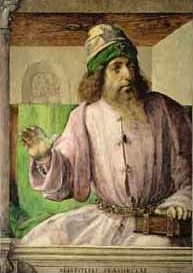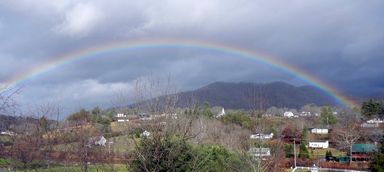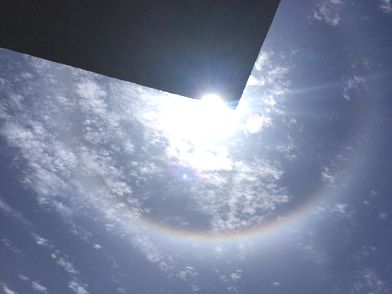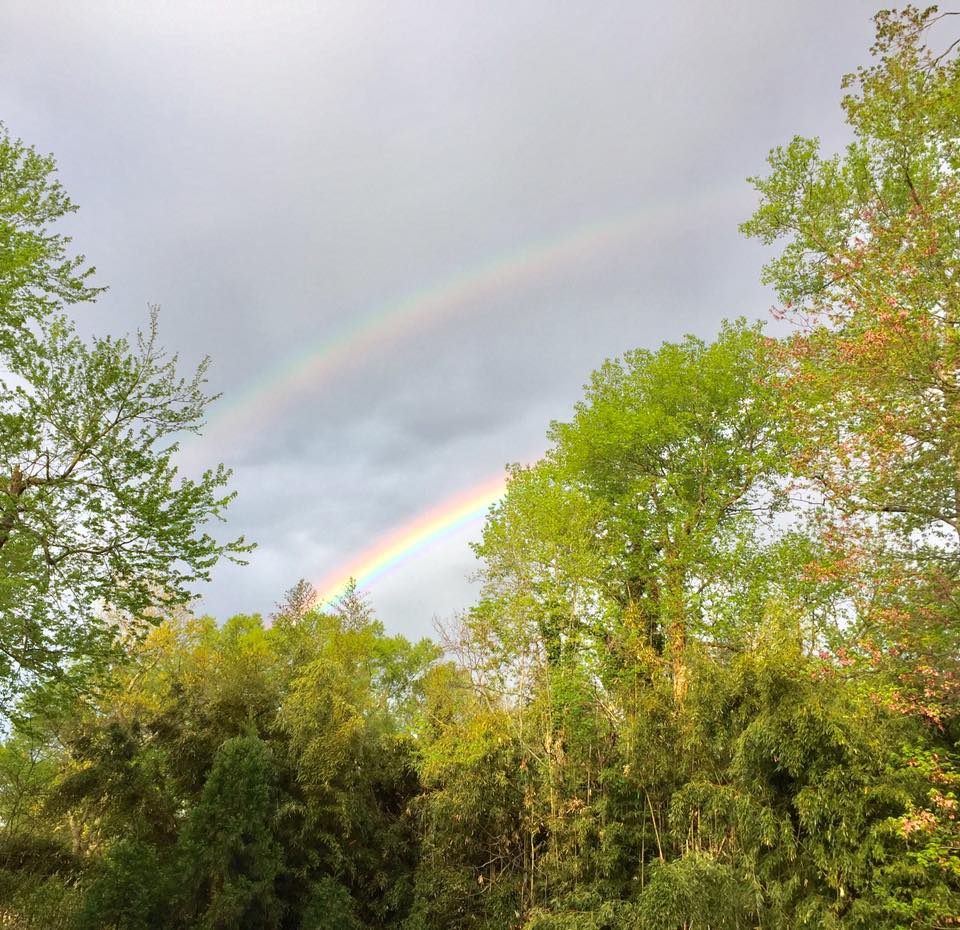Content created: 2015-08-28
File last modified:
Aristotle
Meteorology (Book III: Parts 2-4)
Translated Erwin Wentworth Webster (1880±-1917)
Procursus
Much of Aristotle’s writing seeks to explore and explain the physical universe and the principles which govern it, certainly an audacious undertaking. (What other ancient writer sought to understand the differences between rainbows and sun halos?!) Although he was not a bad observer, and he was a determinedly logical thinker, his explanations were rarely subjected to actual experiment, and what made consistent sense ceased to be doubted.

Aristotle. One of a series of paintings of 28 famous scholars made about 1476 by Joos van Wassenhove (Justus van Gent)
(Musée du Louvre, Paris)
As a result, his natural science explanations were more often persuasive than right. (An example in the present text is the contention that a very small mirror cannot reflect shape, but only color. In his defense, available mirrors were polished bronze plaques that did not reflect anything very clearly.)
The persuasiveness of his explanations helps to explain why they were accepted as correct from Aristotle’s own time clear up to Europe’s 17th century “Enlightenment” and the dawn of true science, anchored not in rereading Aristotle, but in carefully and critically observing the natural world and subjecting the resultant models to well conceived experiments capable of showing them to be wrong.
Ancient writers did not possess a well defined scientific vocabulary such as we expect of writers today, and as a result modern readers must be alert to the possibility of words being used in unexpected ways. In the present selection, for example, the word translated “sight” (opseos, ὄψεως) appears in most cases to refer to visible light.
The present text of the Meteorology was translated by Erwin Wentworth Webster (1880±-1917) and was included in W. D. Ross (ed.) 1931 The Works of Aristotle. Oxford: Oxford University Press. Vol. III. In this extract, subtitles and section numbers have been added to facilitate reference and class discussion. They do not correspond to traditional numbering of the Greek text. An internet file of the full text in the same translation is available at http://classics.mit.edu/Aristotle/meteorology.mb.txt. For the Greek text, click here.)
Return to top.
Book III, Part 2
[1] Let us now explain the nature and cause of halo, rainbow, mock suns, and rods, since the same account applies to them all.
[2] We must first describe the phenomena and the circumstances in which each of them occurs.
Descriptions
[3] The halo often appears as a complete circle: it is seen round the sun and the moon and bright stars, by night as well as by day, and at midday or in the afternoon, more rarely about sunrise or sunset.

Rainbow With Ordered Stripes of Color
[4] The rainbow never forms a full circle, nor any segment greater than a semicircle. At sunset and sunrise the circle is smallest and the segment largest: as the sun rises higher the circle is larger and the segment smaller. After the autumn equinox in the shorter days it is seen at every hour of the day, in the summer not about midday.
[5] There are never more than two rainbows at one time. Each of them is three-coloured; the colours are the same in both and their number is the same, but in the outer rainbow they are fainter and their position is reversed. In the inner rainbow the first and largest band is red; in the outer rainbow the band that is nearest to this one and smallest is of the same colour: the other bands correspond on the same principle.
[6] These are almost the only colours which painters cannot manufacture: for there are colours which they create by mixing, but no mixing will give red, green, or purple. These are the colours of the rainbow, though between the red and the green an orange colour is often seen.
[7] Mock suns and rods are always seen by the side of the sun, not above or below it nor in the opposite quarter of the sky. They are not seen at night but always in the neighbourhood of the sun, either as it is rising or setting but more commonly towards sunset. They have scarcely ever appeared when the sun was on the meridian, though this once happened in Bosporus where two mock suns rose with the sun and followed it all through the day till sunset.
Return to top.
Cause: Reflections
[8] These are the facts about each of these phenomena: the cause of them all is the same, for they are all reflections. But they are different varieties, and are distinguished by the surface from which and the way in which the reflection to the sun or some other bright object takes place.
[9] The rainbow is seen by day, and it was formerly thought that it never appeared by night as a moon rainbow. This opinion was due to the rarity of the occurrence: it was not observed, for though it does happen it does so rarely. The reason is that the colours are not so easy to see in the dark and that many other conditions must coincide, and all that in a single day in the month. For if there is to be one it must be at full moon, and then as the moon is either rising or setting. So we have only met with two instances of a moon rainbow in more than fifty years.
Tiny Mirrors: Colors, Not Shapes
[10] We must accept from the theory of optics the fact that sight is reflected from air and any object with a smooth surface just as it is from water; also that in some mirrors the forms of things are reflected, in others only their colours. Of the latter kind are those mirrors which are so small as to be indivisible for sense. It is impossible that the figure of a thing should be reflected in them, for, if it is, the mirror will be sensibly divisible since divisibility is involved in the notion of figure. But since something must be reflected in them and figure cannot be, it remains that colour alone should be reflected.
[11] The colour of a bright object sometimes appears bright in the reflection, but it sometimes, either owing to the admixture of the colour of the mirror or to weakness of sight, gives rise to the appearance of another colour.
[12] However, we must accept the account we have given of these things in the theory of sensation, and take some things for granted while we explain others.
Return to top.
Book III, Part 3
Shapes: The Halo
[13] Let us begin by explaining the shape of the halo; why it is a circle and why it appears round the sun or the moon or one of the other stars: the explanation being in all these cases the same.

Sun Halo Over Marshall College Dining Hall, UCSD (April, 2015)
[14] Sight is reflected in this way when air and vapour are condensed into a cloud and the condensed matter is uniform and consists of small parts. Hence in itself it is a sign of rain, but if it fades away, of fine weather, if it is broken up, of wind. For if it does not fade away and is not broken up but is allowed to attain its normal state, it is naturally a sign of rain since it shows that a process of condensation is proceeding which must, when it is carried to an end, result in rain. For the same reason these haloes are the darkest.
[15] It is a sign of wind when it is broken up because its breaking up is due to a wind which exists there but has not reached us. This view finds support in the fact that the wind blows from the quarter in which the main division appears in the halo. Its fading away is a sign of fine weather because if the air is not yet in a state to get the better of the heat it contains and proceed to condense into water, this shows that the moist vapour has not yet separated from the dry and firelike exhalation: and this is the cause of fine weather.
[16] So much for the atmospheric conditions under which the reflection takes place. The reflection is from the mist that forms round the sun or the moon, and that is why the halo is not seen opposite the sun like the rainbow.
[17] Since the reflection takes place in the same way from every point the result is necessarily a circle or a segment of a circle: for if the lines start from the same point and end at the same point and are equal, the points where they form an angle will always lie on a circle.
[18] …
[19] Haloes are commoner round the moon because the greater heat of the sun dissolves the condensations of the air more rapidly.
[20] Haloes are formed round stars for the same reasons, but they are not prognostic in the same way because the condensation they imply is so insignificant as to be barren.
Return to top.
Book III, Part 4
Shapes: The Rainbow
[21] We have already stated that the rainbow is a reflection: we have now to explain what sort of reflection it is, to describe its various concomitants, and to assign their causes.
[22] Sight is reflected from all smooth surfaces, such as are air and water among others. Air must be condensed if it is to act as a mirror, though it often gives a reflection even uncondensed when the sight is weak.
[23] …
[24] So promontories in the sea “loom” when there is a south-east wind, and everything seems bigger, and in a mist, too, things seem bigger: so, too, the sun and the stars seem bigger when rising and setting than on the meridian.
[25] But things are best reflected from water, and even in process of formation it is a better mirror than air, for each of the particles, the union of which constitutes a raindrop, is necessarily a better mirror than mist.
Return to top.
[26] Now it is obvious and has already been stated that a mirror of this kind renders the colour of an object only, but not its shape. Hence it follows that when it is on the point of raining and the air in the clouds is in process of forming into raindrops but the rain is not yet actually there, if the sun is opposite, or any other object bright enough to make the cloud a mirror and cause the sight to be reflected to the object then the reflection must render the colour of the object without its shape.
[27] Since each of the mirrors is so small as to be invisible and what we see is the continuous magnitude made up of them all, the reflection necessarily gives us a continuous magnitude made up of one colour; each of the mirrors contributing the same colour to the whole.
[28] We may deduce that since these conditions are realizable there will be an appearance due to reflection whenever the sun and the cloud are related in the way described and we are between them. But these are just the conditions under which the rainbow appears. So it is clear that the rainbow is a reflection of sight to the sun.
The Rainbow Opposite the Sun
[29] So the rainbow always appears opposite the sun whereas the halo is round it. They are both reflections, but the rainbow is distinguished by the variety of its colours. The reflection in the one case is from water which is dark and from a distance; in the other from air which is nearer and lighter in colour.
The Colors of the Rainbow
[30] White light through a dark medium or on a dark surface (it makes no difference) looks red. We know how red the flame of green wood is: this is because so much smoke is mixed with the bright white firelight: so, too, the sun appears red through smoke and mist. That is why in the rainbow reflection the outer circumference is red (the reflection being from small particles of water), but not in the case of the halo. The other colours shall be explained later.
[31] …
[32] The rainbow that is seen when oars are raised out of the sea involves the same relative positions as that in the sky, but its colour is more like that round the lamps, being purple rather than red. The reflection is from very small particles continuous with one another, and in this case the particles are fully formed water. We get a rainbow, too, if a man sprinkles fine drops in a room turned to the sun so that the sun is shining in part of the room and throwing a shadow in the rest. Then if one man sprinkles in the room, another, standing outside, sees a rainbow where the sun’s rays cease and make the shadow. Its nature and colour is like that from the oars and its cause is the same, for the sprinkling hand corresponds to the oar.
Colors
[33] That the colours of the rainbow are those we described and how the other colours come to appear in it will be clear from the following considerations. We must recognize, as we have said, and lay down:
- first, that white colour on a black surface or seen through a black medium gives red;
- second, that sight when strained to a distance becomes weaker and less;
- third, that black is in a sort the negation of sight: an object is black because sight fails; so everything at a distance looks blacker, because sight does not reach it.
[34] …
[35] The following fact further is worth noticing. When there is a cloud near the sun and we look at it does not look coloured at all but white, but when we look at the same cloud in water it shows a trace of rainbow colouring. Clearly, then, when sight is reflected it is weakened and, as it makes dark look darker, so it makes white look less white, changing it and bringing it nearer to black.
Return to top.
Three Basic Colors: Red, Green, Violet
[36] When the sight is relatively strong the change is to red; the next stage is green, and a further degree of weakness gives violet.
[37] No further change is visible, but three completes the series of colours (as we find three does in most other things), and the change into the rest is imperceptible to sense. Hence also the rainbow appears with three colours.
[38] This is true of each of the two, but in a contrary way. The outer band of the primary rainbow is red: for the largest band reflects most sight to the sun, and the outer band is largest. The middle band and the third go on the same principle. So if the principles we laid down about the appearance of colours are true the rainbow necessarily has three colours, and these three and no others.
Imagined Colors
[39] The appearance of yellow is due to contrast, for the red is whitened by its juxtaposition with green. We can see this from the fact that the rainbow is purest when the cloud is blackest; and then the red shows most yellow. (Yellow in the rainbow comes between red and green.)
[40] So the whole of the red shows white by contrast with the blackness of the cloud around: for it is white compared to the cloud and the green. Again, when the rainbow is fading away and the red is dissolving, the white cloud is brought into contact with the green and becomes yellow.
[41] But the moon rainbow affords the best instance of this colour contrast. It looks quite white: this is because it appears on the dark cloud and at night. So, just as fire is intensified by added fire, black beside black makes that which is in some degree white look quite white.
[42] Bright dyes too show the effect of contrast. In woven and embroidered stuffs the appearance of colours is profoundly affected by their juxtaposition with one another (purple, for instance, appears different on white and on black wool), and also by differences of illumination. Thus embroiderers say that they often make mistakes in their colours when they work by lamplight, and use the wrong ones.

Double Rainbow With Reversed Colors
(
Photo courtesy of Sydney Smith)
Double Rainbows
[43] We have now shown why the rainbow has three colours and that these are its only colours. The same cause explains the double rainbow and the faintness of the colours in the outer one and their inverted order. When sight is strained to a great distance the appearance of the distant object is affected in a certain way: and the same thing holds good here.
[44] So the reflection from the outer rainbow is weaker because it takes place from a greater distance and less of it reaches the sun, and so the colours seen are fainter. Their order is reversed because more reflection reaches the sun from the smaller, inner band. For that reflection is nearer to our sight which is reflected from the band which is nearest to the primary rainbow. Now the smallest band in the outer rainbow is that which is nearest, and so it will be red; and the second and the third will follow the same principle.
[45] …
An interactive quiz is available to doublecheck your understanding of this page.
Quiz,
Return to top.



